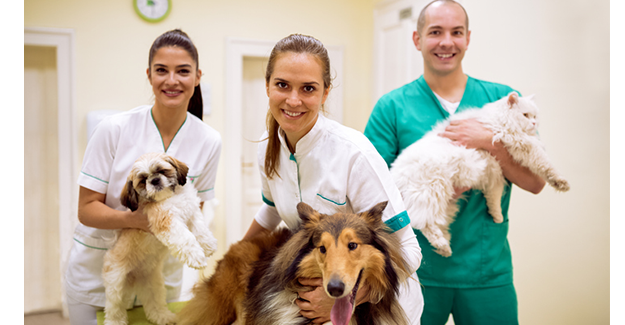NEWStat®
 Subscribe to get NEWStat delivered directly to your inbox! Delivered every Tuesday, Thursday, and Saturday, NEWStat is boosted by artificial intelligence to deliver a newsletter that is tailored to you.
Subscribe to get NEWStat delivered directly to your inbox! Delivered every Tuesday, Thursday, and Saturday, NEWStat is boosted by artificial intelligence to deliver a newsletter that is tailored to you.
Featured article
Why staff retention deserves your attention in the New Year
AAHA surveyed nearly 15,000 veterinary professionals and learned that 30% plan to leave their current job within the coming year. What might make them want to stay? It starts with the right goals.
Trends free article
How Do We Keep Good People in Clinical Practice?
New insights from an AAHA survey into why people in vet med leave, and what could make them want to stay.
Recent articles
-
March 31, 2009
Summary of the February 2009 AAHA Economic Impact Survey
The recession has affected veterinary practice revenues in the last half of 2008, but our sample estimates that this trend will not be as negative in the first half of 2009. For the last six months of 2008, half (50%) of the respondents reported that revenues were lower than during the first half of 2008, while less than a third (31%) saw an increase in revenues. Coincidentally, the average decrease in revenues was the same size as the average increase (9%), but unfortunately many more veterinarians reported decreases than increases. There were statistically significant differences in revenue declines across FTE categories. Of the practices that experienced decreases in revenue, the smallest practices (1.0 FTE) experienced greater decreases (12%) than did other practices. These data appear to be fairly accurate, with nearly nine out of ten (88%) veterinarians basing their responses on actual practice data instead of ‘gut feel.’ -
March 17, 2009
Stimulating facts for your practice
You probably don’t have time to read through the 407-page, $787 billion “American Recovery and Reinvestment Act of 2009.” But the economic stimulus package, signed into law by President Obama on Feb. 17, contains some important information for individuals, as well as small businesses such as veterinary practices. If you are looking to secure a loan from the U.S. Small Business Association (SBA), or purchase some new equipment, now might be the time to do so. The package includes $730 million for the SBA, and makes changes to the SBA’s lending and investment programs. The Obama Administration also announced this week a series of measures directed at making more credit available to small businesses, and several small-business-friendly tax initiatives. -
March 17, 2009
California VMB approves controversial technician exam rule
Unregistered veterinary assistants in California without a formal education have a rare opportunity this year, but not everyone is happy about it. Under a new regulation implemented by the California Veterinary Medical Board (CVMB), veterinary assistants with at least five years’ experience and 24 hours of continuing education credits can apply for the state’s Registered Veterinary Technician (RVT) exam. Applicants must also have their supervising veterinarian attest to their competence in entry-level technician skills. However, state and national veterinary groups are at best wary of the regulation, with some organizations voicing strong opposition, saying the rule puts the public and animals at risk. -
March 3, 2009
Routine care falling off around the US
If your practice is seeing a drop-off in routine visits from clients, you are not alone. Practices from across the country report that routine care such as wellness exams and vaccinations seem to be declining due to the economy. Practices that are seeing this phenomenon are coping with it in different ways, but some common threads are staff training, client education and making sure clients feel that the hospital’s services are valuable. -
March 3, 2009
North Carolina debates shelter euthanasia law
If it passes, a bill before the North Carolina State Legislature would ban the use of carbon monoxide gas chambers as a way of euthanizing shelter animals. House Bill 6 proposes a ban on the use of CO gas chambers, which are used in more than 30 counties in the state, according to local media. The new law would require shelter euthanasias to be performed by only licensed veterinarians or certified euthanasia technicians using intravenous, intraperitoneal, or oral administration of sodium pentobarbital or its approved equivalent. It also adds the provision: “No animal shelter may maintain on its premises any facility or equipment used for the euthanasia of animals with carbon monoxide or any other gas.” But the North Carolina Veterinary Medical Association (NCVMA) opposes the bill, which goes before the House Agriculture Committee this week. -
February 17, 2009
New 30-minute rabies test causes stir
A new rabies test has stirred up intense interest – and skepticism – in the zoonosis community. Warwick, N.Y.--based Dyne Immune announced early this month the release of a portable rabies test kit that can be used on animal saliva that gives results in 30 minutes. “The screen allows veterinarians, animal control officers and other professionals to check for rabies in animals that are still alive, eliminating the long wait (10 to 14 days) and hefty price tag associated with typical post-mortem rabies testing,” says the company’s press release. Charles Rupprecht, VMD, PhD, chief of the CDC rabies program, said his office has received many calls about the new test. “We started getting queries from around the world about it,” Rupprecht said. “It was fairly clear that there was a lot of interest in this.” -
February 17, 2009
Filling in the cracks and picking up the pieces: Chelonian shell repair
Practices that treat exotics or wildlife may be familiar with this situation: A person comes in with a turtle that has been run over by a car or chewed on by a dog and says: “Can you help?” What do you do first? Triage is the initial step, according to Gregory Fleming, DVM, DACZM, a veterinarian at Disney’s Animal Kingdom. Fleming recently published a paper describing the process of assessment, treatment and rehabilitation for chelonians with shell damage. He also presented his work at the North American Veterinary Conference in Orlando, Fla., in January. -
February 3, 2009
Student Debt: Threat or Opportunity?
Several perspectives on this topic are covered in depth in a special February issue of Trends magazine. It’s time to take another look at veterinary student debt, according to AAHA President-Elect John Tait, DVM, MBA, CFP. As framed to date, discussions about student debt, often dubbed the elephant in the room, have focused on the fact that the salaries of recent graduates are insufficient to pay student loans and attain the lifestyle generally associated with professional status. But the value of a veterinary degree isn’t measured by the salary you earn early in your career, Tait maintained during a session at the North American Veterinary Conference in January. -
February 3, 2009
Practices take a hit from ice storm
Hundreds of thousands of people in Kentucky, Arkansas and Missouri lost their electricity in last week’s devastating ice storm, and veterinary practices were not immune to the damage. Some fared better than others, however. Ron Eby, DVM, of St. Francis Veterinary Clinic in Green Forest, Ark., said his practice was without electricity for a week. The storm hit Jan. 26, and Eby’s practice lost power the next day until Feb. 2, he said. Fortunately no animals suffered at the practice. Several animals were being boarded there, but because the building rests on a 4,500-square-foot concrete slab, the indoor area remained at 62 degrees even with no heat. “The worst thing for us was the loss of a whole week’s work,” Eby said. “It’s amazing how dependent we are on the phones and electricity.” -
January 20, 2009
NAVC economic sessions offer predictions, advice
Half of veterinarians participating in a survey this week said they expect to cut staff hours in an effort to save jobs during 2009. The survey was conducted during a symposium on economic issues and the recession at the North American Veterinary Conference in Orlando, Fla. Student debt, economic forecasts, and lessons from a multi-practice owner weathering the recession in the long-struggling Midwest were also front-and-center at the conference.





